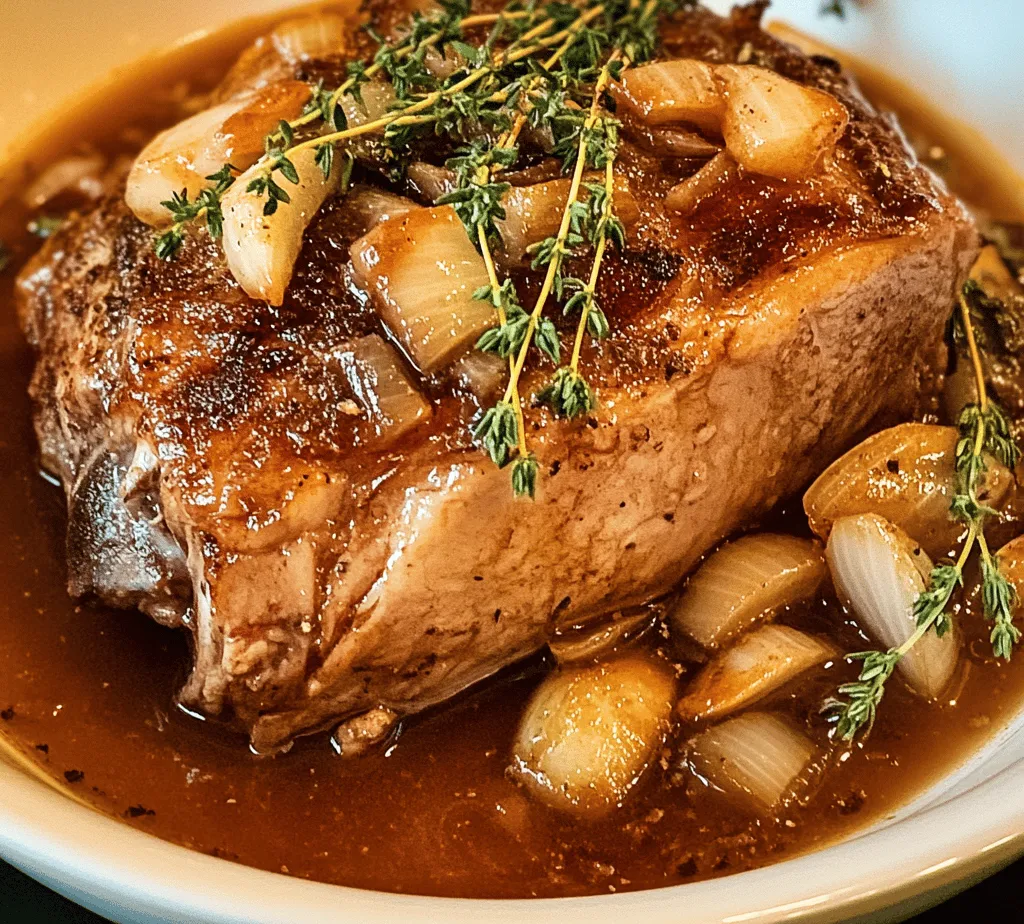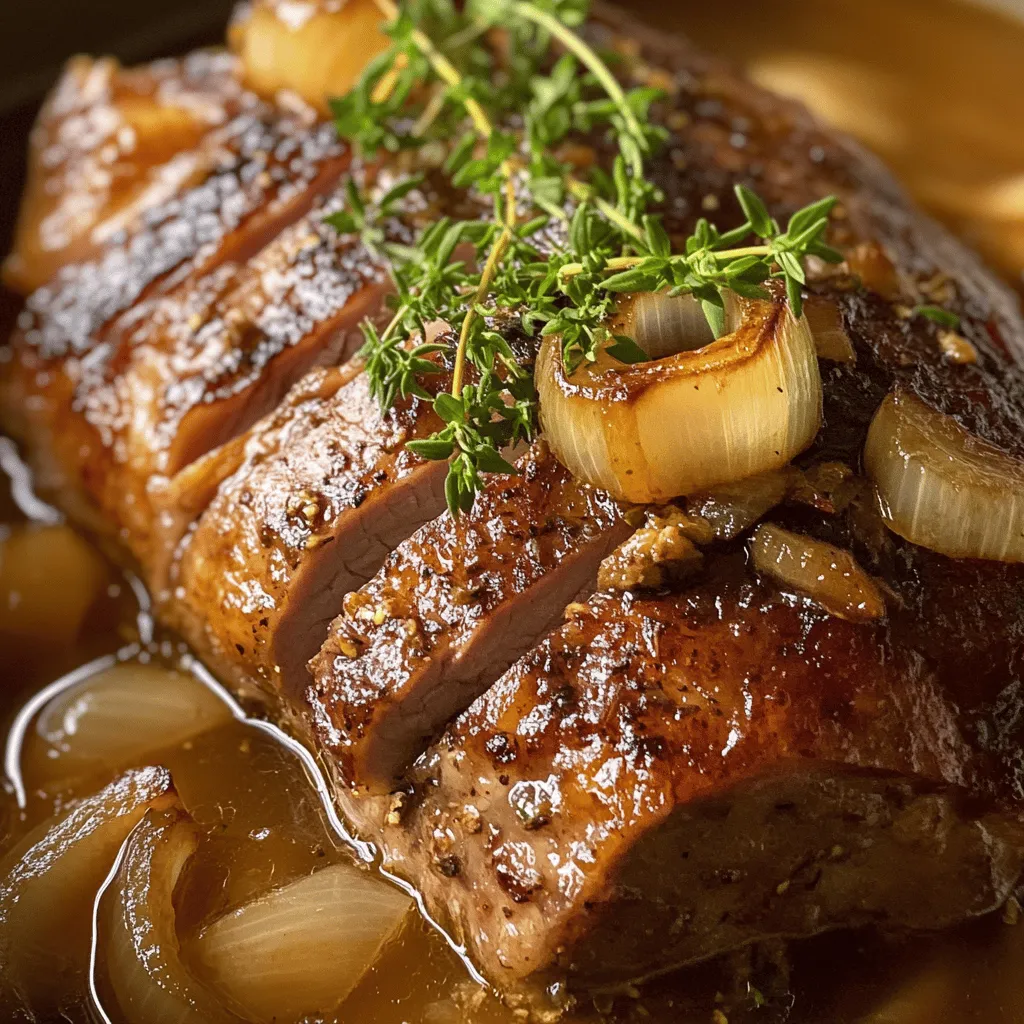Introduction
As the leaves turn and the air grows crisp, there’s nothing quite like the comfort of a warm, hearty meal to bring joy to the table. One such dish that embodies the essence of autumn is Apple Cider Braised Pork Shoulder. This recipe is more than just a meal; it’s a celebration of seasonal flavors and the art of slow cooking. The combination of tender pork shoulder braised in a rich apple cider sauce, infused with spices, transforms this humble cut of meat into a mouthwatering masterpiece that beckons family and friends to gather around.
Braised dishes like this one are particularly appealing as they not only fill the home with enticing aromas but also provide a sense of warmth and comfort, making them perfect for cooler months. The slow cooking process allows the pork to absorb the flavors of the apple cider and spices, resulting in a dish that is both savory and slightly sweet. This unique flavor profile is what sets Apple Cider Braised Pork Shoulder apart from other traditional braises, offering a delightful twist that will satisfy even the most discerning palate.
The Allure of Braised Pork Shoulder
Pork shoulder, often referred to as “pork butt” or “Boston butt,” is a cut of meat that is ideal for slow cooking due to its rich marbling and connective tissue. When braised, the fat melts into the meat, resulting in a tender and juicy dish that practically falls apart with a fork. The beauty of this cut lies in its affordability and versatility, making it a popular choice for home cooks and chefs alike.
Braising, a cooking method that involves searing meat at high heat followed by slow cooking in liquid, has deep roots in culinary traditions around the world. This technique not only enhances flavors but also transforms tougher cuts of meat into tender delicacies. By combining the heat of the oven with the moisture of apple cider, this recipe takes full advantage of braising’s benefits, ensuring that the pork shoulder becomes melt-in-your-mouth tender.
Using apple cider in this dish elevates the flavor profile significantly. The natural sweetness of the cider complements the savory notes of the pork, while the acidity helps to tenderize the meat, creating a perfect balance. Moreover, apple cider is rich in flavor, offering hints of spices and fruit that enhance the overall dish.
Ingredients Overview
To create this delicious Apple Cider Braised Pork Shoulder, you will need the following ingredients. Each plays a vital role in building the dish’s unique flavor and texture.
Pork Shoulder
The star of this recipe is undoubtedly the pork shoulder. This cut is characterized by its rich, fatty texture, which makes it perfect for braising. When cooked low and slow, the connective tissues break down, resulting in succulent and flavorful meat. Aim for a bone-in pork shoulder if possible, as the bone adds extra flavor during the cooking process.
Apple Cider
Choosing the right apple cider is crucial for achieving the best results. Look for a high-quality, unfiltered apple cider that has a rich flavor profile. Fresh-pressed cider is ideal, but if that’s not available, any good-quality store-bought cider will work. Avoid using apple-flavored beverages, as they may contain added sugars and artificial flavors that can detract from the dish.
Aromatics
Onion and garlic are essential aromatics that contribute depth to the flavor of the dish. The onion adds sweetness and a savory base, while garlic brings an aromatic punch. Together, they create a fragrant foundation that enhances the overall taste of the braise.
Broth
For this recipe, you have the option to use either chicken or vegetable broth. Chicken broth will impart a richer flavor, while vegetable broth provides a lighter base. Choose whichever option aligns with your taste preferences or dietary needs.
Spices
The blend of spices used in this dish is what truly sets it apart. Ground cinnamon adds warmth and a hint of sweetness, while cumin provides an earthy undertone. Smoked paprika contributes a subtle smokiness that enhances the overall flavor. Don’t forget the salt and pepper—these staples are essential for seasoning the dish and bringing all the flavors together.
Apple Cider Vinegar and Brown Sugar
To balance the sweetness of the apple cider, we incorporate apple cider vinegar and brown sugar. The vinegar adds a tangy note, while the brown sugar enhances the dish’s sweetness and depth. This combination creates a perfect harmony of flavors.
Olive Oil
Olive oil is essential for the initial searing of the pork shoulder. Searing the meat in olive oil not only adds flavor but also helps create a beautiful crust, sealing in the juices and ensuring a tender final product.
Fresh Thyme
Finally, fresh thyme serves as a garnish and adds a layer of herbal flavor to the dish. The aromatic qualities of thyme complement the apple cider and pork, enhancing the overall taste.
Step-by-Step Instructions
Before diving into the cooking process, it’s essential to preheat the oven to the right temperature. Preheating is a crucial step in braising, as it ensures that the meat cooks evenly and properly. Set your oven to 325°F (163°C) for the best results.
Now that your oven is preheated, it’s time to prepare the pork shoulder for braising. Start by patting the pork dry with paper towels. This step is vital as it removes excess moisture, allowing for a better sear. Season the pork generously with salt and pepper on all sides, ensuring that every inch of the meat is well-seasoned.
Next, heat a large, heavy-bottomed Dutch oven or oven-safe pot over medium-high heat and add a drizzle of olive oil. Once the oil is shimmering but not smoking, carefully place the seasoned pork shoulder in the pot. Sear the pork for about 4-5 minutes on each side, or until it develops a rich, golden-brown crust. This step is essential, as the caramelization adds depth and complexity to the final dish.
Once the pork is seared to perfection, remove it from the pot and set it aside on a plate. In the same pot, add the chopped onion and sauté for about 3-4 minutes, or until softened and translucent. Follow with minced garlic, cooking for an additional minute until fragrant. This aromatic base will infuse the braising liquid with flavor.
Now it’s time to deglaze the pot. Pour in the apple cider, scraping up any browned bits from the bottom of the pot. These bits are packed with flavor and will enhance the braising liquid significantly. After deglazing, return the pork shoulder to the pot, nestling it into the aromatic mixture.
Next, add in your choice of broth, ensuring that the liquid covers at least half of the pork shoulder. This will provide enough moisture to keep the meat tender during the cooking process. Sprinkle in the ground spices—cinnamon, cumin, and smoked paprika—and stir to combine. Finally, drizzle in the apple cider vinegar and sprinkle the brown sugar over the top.
Once everything is well mixed, bring the liquid to a simmer. This initial simmering step is important as it helps to meld the flavors before the long cooking process begins. After a few minutes, cover the pot with a lid and transfer it to the preheated oven.
Let the pork shoulder braise in the oven for approximately 3 to 4 hours, or until it becomes fork-tender. The long, slow cooking time is what allows the flavors to develop fully, resulting in a dish that is rich, complex, and utterly delicious.
As the pork shoulder braises, the apple cider will work its magic, infusing the meat with sweetness and acidity, while the spices create a warm and inviting aroma that will fill your kitchen.
Stay tuned for the next part, where we will explore the final steps of this delectable dish, including how to serve it and some tips for the best results.

Prepare the Pork Shoulder
When preparing your pork shoulder, the key is to enhance its natural flavor and tenderness. Start by selecting a quality piece of meat, ideally with a good amount of marbling. This fat will render during cooking, keeping the pork moist and infusing it with flavor.
Begin by trimming excess fat from the pork shoulder, leaving a thin layer to help with flavor retention without causing greasiness. Next, season the meat generously with salt and pepper. This step is crucial as it draws out moisture and enhances the overall flavor. For added depth, consider rubbing the pork with a mixture of garlic powder, onion powder, smoked paprika, and a pinch of cayenne pepper for a subtle kick. Allow the seasoned pork to rest for at least 30 minutes at room temperature; this not only helps the seasoning penetrate but also ensures even cooking.
Sear the Pork
Searing the pork shoulder is an essential technique that takes advantage of the Maillard reaction, a chemical reaction that occurs when proteins and sugars in meat are exposed to high heat. This reaction creates a rich, deep brown crust on the surface of the pork, enhancing its flavor profile significantly.
To sear the pork shoulder, heat a heavy-bottomed Dutch oven or a large skillet over medium-high heat and add a couple of tablespoons of oil, such as canola or vegetable oil, due to their high smoke points. When the oil is shimmering, carefully place the pork in the pot, ensuring not to crowd it. Sear each side for about 4-5 minutes, or until a golden-brown crust forms. This process not only adds flavor but also helps to lock in the juices, making the final braised dish even more succulent.
Sauté Aromatics
Once your pork is beautifully seared, remove it from the pot and set it aside. In the same pot, lower the heat to medium and add aromatics like chopped onions and minced garlic. Sautéing these ingredients is crucial for building flavor; as the onions become translucent and golden, they release their natural sugars, contributing to caramelization.
Allow the onions to cook for about 5-7 minutes until they are soft and starting to brown. Then, add minced garlic and sauté for an additional minute. Garlic cooks quickly, and you want to avoid burning it, as burnt garlic can impart an unpleasant bitterness to your dish. The sweet, caramelized onions and fragrant garlic will serve as a flavorful base for your braising liquid.
Deglaze the Pot
After sautéing the aromatics, it’s time to deglaze the pot. This process involves adding a liquid—often wine or broth—to lift the flavorful browned bits, known as fond, from the bottom of the pot. These bits are packed with flavor and will enhance your braising liquid.
Pour in about a cup of apple cider or broth, scraping the bottom of the pot with a wooden spoon to release the fond. This step is essential as it incorporates all the rich flavors developed during the searing process into the braising liquid. Allow the liquid to simmer for a couple of minutes, letting it reduce slightly and intensify in flavor.
Braise the Pork
With the pot deglazed, it’s time to braise the pork. Return the seared pork shoulder to the pot, nestling it among the aromatic mixture. Pour in enough apple cider to cover about two-thirds of the pork. This will provide the necessary moisture for braising while infusing the meat with a sweet, tangy flavor that perfectly complements the richness of the pork.
Cover the pot with a tight-fitting lid and bring the liquid to a gentle simmer. Braising relies on both moisture and time, so maintain a low simmer throughout the cooking process. This method allows the tough fibers in the pork shoulder to break down, resulting in tender, pull-apart meat.
Cook Low and Slow
Cooking the pork shoulder low and slow is key to achieving optimal tenderness and flavor. Aim for a cooking temperature of around 300°F (150°C). Depending on the size of your pork shoulder, you’ll want to braise it for about 3 to 4 hours. The goal is to reach an internal temperature of at least 190°F (88°C), at which point the collagen in the meat will have broken down, creating a tender texture.
Check the pork periodically, and if necessary, add more apple cider or broth to ensure it stays moist throughout the cooking process. The long, slow cooking time allows the flavors to meld beautifully, creating a harmonious dish that is both comforting and satisfying.
Finish and Serve
Once the pork shoulder is tender and cooked through, remove it from the pot and let it rest for at least 15 minutes before slicing or shredding. Resting allows the juices to redistribute throughout the meat, ensuring each bite is juicy and flavorful.
To serve, slice the pork shoulder against the grain or shred it using two forks for a more rustic presentation. Drizzle some of the braising liquid over the meat to enhance the flavor and keep it moist.
Flavor Profiles and Pairings
The combination of apple cider, spices, and tender pork creates a delightful flavor profile that is both savory and slightly sweet. The natural acidity of the apple cider balances the richness of the pork, making each bite an explosion of flavor.
For side dishes, consider serving the braised pork with creamy mashed potatoes, which can soak up the delicious juices, or roasted vegetables like carrots and Brussels sprouts, providing a nice contrast in texture.
When it comes to beverage pairings, a dry white wine or a light-bodied red complements the dish well. Alternatively, a refreshing apple cider or a crisp beer can enhance the meal experience and tie in with the flavors of the dish.
Nutritional Insights
Pork shoulder is a flavorful cut of meat that provides several nutritional benefits. It is rich in protein, essential for muscle repair and growth, and contains zinc and B vitamins, which support overall health.
While it is higher in fat compared to leaner cuts, moderation is key. A standard serving size is around 3 to 4 ounces, making it easy to enjoy this dish while maintaining a balanced diet. Pairing the pork with nutrient-dense sides like roasted vegetables or a fresh salad can create a well-rounded meal.
Cooking Tips and Variations
If you wish to adjust the recipe for different dietary preferences, consider using a different cut of meat, such as a pork loin or chicken thighs. These options will yield a slightly different texture but can still provide excellent results.
For those looking for convenience, this recipe can easily be adapted for slow cookers or Instant Pots. For slow cookers, follow the same steps for seasoning, searing, and sautéing before placing everything in the slow cooker on low for 6-8 hours. In an Instant Pot, you can reduce the braising time significantly, cooking under high pressure for about 60-75 minutes, followed by a natural release.
To explore different flavor profiles, experiment with herbs and spices. Adding fresh thyme, rosemary, or even a dash of cinnamon can elevate the dish and provide a unique twist on the classic recipe.
Conclusion
The Apple Cider Braised Pork Shoulder is more than just a meal; it’s a celebration of flavors that bring warmth and comfort to any dining experience. The combination of tender pork, sweet apple cider, and aromatic spices creates a dish that is perfect for family gatherings or special occasions.
Reflecting on the process of making this dish, from seasoning the meat to the final presentation, highlights the joy of cooking and the satisfaction found in sharing a homemade meal with loved ones. Whether it’s a cozy weeknight dinner or a festive holiday feast, this recipe is sure to become a cherished favorite, inviting laughter and conversation around the table. So roll up your sleeves, gather your ingredients, and indulge in the delightful experience of cooking and savoring Apple Cider Braised Pork Shoulder.



